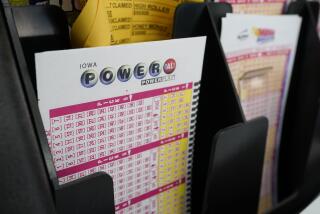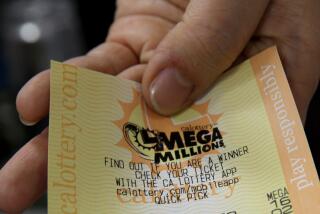After three flush years, lottery sees a downturn
SACRAMENTO — After three years of record sales, the California Lottery has hit a slump, triggering introspection about how the 22-year-old agency does business.
Lottery officials blame a lack of big jackpots in its Mega Millions and SuperLotto Plus games for forcing them to lower their projected revenues this year from $3.6 billion to $3.2 billion. By law, just over a third of lottery income goes to education. Last year, the lottery gave $1.29 billion to schools. This year, because of lower revenues, the lottery expects to give schools $1.13 billion, a loss of $160 million.
“We’re seeing a definite trending down in sales,” Lottery Director Joan Borucki told the Lottery Commission on Wednesday.
Such a midyear correction has not occurred at the lottery in more than a decade. Concerned officials say they have hired marketing consultants to study their “brand image” and suggest improvements.
They will examine the Saturday half-hour “Big Spin” television show to see whether it’s worth keeping, and survey players and store owners about the games. Another point for review is whether higher payouts on games might boost sales.
When California joined the 11-state Mega Millions game two years ago, lottery officials hailed it as a giant-jackpot draw that would boost sales by half a billion dollars a year. On Wednesday, the Lottery Commission voted to downgrade its Mega Millions sales projections for this fiscal year from $560 million to $355 million.
Sales are driven largely by prize size, and for the first half of this fiscal year Mega Millions jackpots were significantly below average. That’s because players won smaller jackpots, and jackpots grow each time there is no winner.
The average Mega Millions jackpot in the last fiscal year was $83 million. So far this fiscal year, it is $50 million. However, officials are hoping the rest of the year brings big jackpots like the current $267 million. There could be a winner Friday.
California isn’t alone in suffering a Mega Millions slump -- sales are off 30% on average compared with last year in the dozen states that participate in the game.
Sales for California’s SuperLotto Plus game, also experiencing fewer big jackpots than usual, declined so much in the last six months that lottery officials have dropped their year-end revenue projections for the game by 12%, to $685 million.
The sales decline for these “draw” games, which depend upon the random selection of numbers, will in turn affect the lottery’s popular and lucrative Scratchers games, which involve cardboard tickets players scratch with a coin to reveal potential prizes.
That’s because for a decade the lottery has shifted some money from the draw games to augment Scratchers prizes, which has boosted sales of those games.
Backers of the initiative that created the lottery promised that it would bolster funding for California schools. Jack O’Connell, superintendent of public instruction, said the question he’s asked the most as he travels the state giving speeches is, “What about all the lottery money?”
“It’s relatively small, yet the perception is that schools are flush with funding as a result of all this lottery money,” he said.
California schools would get more than $66 billion under Gov. Arnold Schwarzenegger’s proposed budget this year. Only $1.13 billion of that will come from the lottery if the revised sales revenues are on the mark.
“Every nickel counts,” O’Connell said. But “I’ve always said the lottery funding is not stable, not predictable. It fluctuates from year to year,” he said.
Richard McGowan, a Boston College professor of economics who has written books about the gambling industry, agreed that “to try to build a base of revenue on lotteries is really difficult,” especially in a state with as many casinos as California.
People quickly get “jackpot fatigue,” he said, and stop buying tickets until prizes become huge.
McGowan suggested state lotteries consider more one-time games, such as the raffle that California launched Feb. 5 in its latest attempt to attract players. As many as 10 $1-million winners could be chosen when the game ends March 17.
Another alternative, McGowan said, is to structure them like Spain’s “El Gordo,” in which drawings are held once a year, prizes are huge and tickets are so expensive that people need to pool their money to buy them.
“If you look at the history of lotteries in this country in general, they were one-time affairs,” he said. “I think the state shouldn’t get itself addicted to the lottery revenue.”
*


